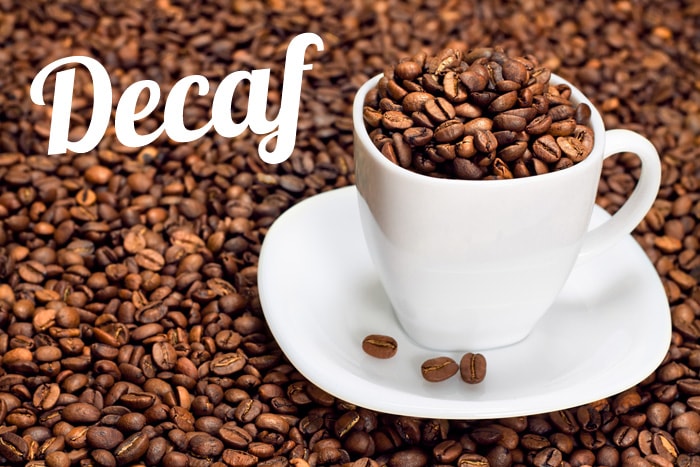
Written By: Christina Newberry
Reviewed By: Gloria Tsang, RD
Title: Registered Dietitian
Last Updated on:

In North America, we love our coffee. According to the National Coffee Association, 56% of Americans drink coffee every single day. But sometimes, you might crave the taste and warmth of coffee without the jolt of caffeine, especially if you want to savor a coffee after dinner. It used to be that decaf coffee options were universally disappointing (and made with potentially toxic chemicals), but decaf coffee has come a long way in recent years. With a little research, you may even be able to find a decaf coffee brand that tastes as good as your regular cup of joe.

Table of Contents
When choosing a decaf beverage so you can enjoy a warm drink without the caffeine, there are a few items to keep in mind, including your own taste preference and the process used for decaffeination.
All coffee starts out with caffeine in it, so any decaf coffee by definition has gone through some kind of decaffeination process. To count as decaf, the coffee must have 97% of its caffeine removed. The processes used to get that caffeine out can vary quite a bit, and some may use surprising chemicals.
You may have heard that the substances used to remove caffeine from decaf coffee are toxic. This belief is mainly held over from previous decaffeination methods that regularly used potentially toxic substances as solvents to remove caffeine. The methods in use today are generally much gentler and safer, but you may still be surprised about how the caffeine is removed from your coffee. Three basic methods of removing caffeine from coffee are in use today:
If you have a favorite coffee chain or local coffee shop, ask the barista to recommend a decaf product for you based on your favorite regular coffee flavor. If you enjoy a cup of decaf you’re served at a restaurant or a friend’s home, ask which brand they use. Of course, if you have a favorite brand you buy for regular home brewing, you should check to see if they have a decaf product. Most people agree that the fresher the decaf beans, the better the taste. So if you have a grinder at home, it’s best to buy decaf beans and grind them just before brewing.
Herbal tea is always an option, of course, but it doesn’t give you the same rich taste that you expect from coffee. So what about herbal coffee? Yes, you can now buy herbal “coffee,” a decaf hot drink that isn’t really coffee at all, but a blend of ingredients like herbs, fruits, grains, and nuts designed to taste like coffee. This may not be for hard-core coffee lovers, but some people swear by it. If you want to learn more, check out the popular brand Teeccino.
Sometimes you want the warm, rich taste of coffee without the caffeine. If you’re trying to cut back on your caffeine intake, try some of the options described in this article to find a decaf coffee or coffee alternative that you really enjoy.
Tell Us: Which brand of decaf do you like?
Alumni: University of Victoria – Christina Newberry is a writer and editor whose work has appeared in national and local magazines and newspapers. With a Bachelor’s degree in English and Anthropology from the University of Victoria and a Journalism Certificate from Langara College, Christina brings keen curiosity and the love of a good story to her work with HealthCastle.com.
Christina is a passionate traveler and urban gardener with an interest in vegetarian eating and making good, tasty food from scratch. Sharing lessons learned from her own experiences, Christina writes about lifestyle topics for HealthCastle, with a focus on eating well at home and on the road.